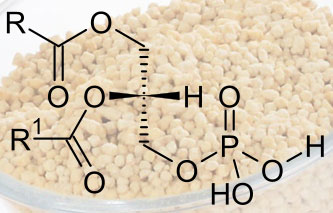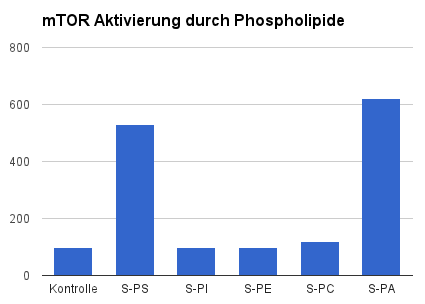Phosphatidic acid - the muscle building substance
 Not a month goes by without reports of new supplements. 90-95% of these new remedies turn out to be a soap bubble sooner or later. This article is about a fairly recent discovery, the Phosphatidsäure, and what it can possibly do for you.
Not a month goes by without reports of new supplements. 90-95% of these new remedies turn out to be a soap bubble sooner or later. This article is about a fairly recent discovery, the Phosphatidsäure, and what it can possibly do for you.
Before we present published results of studies, I would like to explain to you what phosphatidic acid is and where we can find it naturally.
mTOR - the signaling molecule that controls muscle growth
Phosphatidic acid is a phospholipid, similar to the well-known phosphatidylcholine. This implies that it is part of cell membranes and possibly also participates in intracellular (= within the cell) stimulus propagation.
You should understand that: Your cell communicates with the environment (and thus also with the nutrients in the blood) primarily via receptors and the signal cascades triggered by them within the cell, which then ultimately trigger an active mechanism.
If we talk about the so-called “anabolic” signal path, then this mostly starts from insulin receptors (but also IGF receptors) - the insulin signal is “passed on” via the “insulin receptor substrate 1” to “PI3K ”(Phosphoinositide-3 kinase) and is transferred to mTOR via“ Akt ”.
Well - we take the simple domino analogy as "PI3K/Akt/mTOR”Signal path together - it's easy for you the anabolic pathway. Anabol implies growth - and that's what it's all about.
Whenever “one” of the dominoes tips over (= is activated), it will have an effect on mTOR.
mTOR is the cellular switch that determines growth. Therefore, every strength athlete cares, consciously or unconsciously, about the activation of the same. Because mTOR ensures the appropriate gene interaction - protein synthesis is strengthened, protein degradation is inhibited, and like muscles, enzymes for glucose metabolism are formed.
Food protein ultimately also has an effect on mTOR - did you know that? (McIver, 2012).
So far, so good - but what does phosphatidic acid have to do with it?
Phosphatidic acid - the most important signaling molecule in muscles?
Attention - this is very interesting and possibly decisive for your future diet:
For a long time it was not clear how the cell converts mechanical stimuli (e.g. strength training) into cellular, i.e. biochemical, events. Or to put it another way: How does the cell know that it should grow after strength training? What sounds so banal to many is in fact an extremely complex interplay of various molecules within the cell.
O'Neill and colleagues delivered incredibly astonishing results in 2009. For a long time it was thought that the cell regulates growth after mechanical stimulation in the same way as after food intake, namely via the "anabolic signaling pathway" discussed above - in fact, strength training seems short ( !) to ensure that PI3K and Akt are “activated”.
But: mTOR was not only activated for a short time, but for a longer period and thus - of course - ensured that the stimulus was converted into anabolic biochemical processes.
But what caused this “long-term” activation of mTOR?
The researchers found that strength training caused the concentration of phosphatidic acid within the muscle cell to increase and activate mTOR.
It means that Phosphatidsäure is responsible for the fact that you are able to build muscles in the first place! Have we found the reason why there are “hard gainers”? Do they just have too little phosphatidic acid in their cells? I don't know - but there is room for speculation.
The new “soy” doping?
Only at the beginning of this year was it examined more closely. Of course, they wanted to know how the exogenous administration of phosphatidic acid affects the muscle cells. Various phospholipids obtained from soy were tested, including the well-known phosphatidylcholine.

S-PS (phosphatidyl serine) and S-PA (phosphatidic acid) increase the activation of the mTOR signaling by up to 600% - S-PI (Phosphatidyl-Inostiol), S-PE (Phosphatidyl-Ethanolamine), S-PC (Phosphatidyl-Choline) do not. (See Joy, 2014)
The results were amazing. Both phosphatidyl serine (S-PS) and phosphatidic acid (S-PA) activated mTOR by up to 600% compared to the control cell.
This means that the administration of phosphatidic acid alone decides whether and to what extent mTOR is activated. As a reminder: mTOR ensures that your muscles grow!
Many researchers thought "What happens if you also train now?"

Effects on muscle and strength development
Said and done.
In the same work, the authors also published the results of in vivo human experiments.
There it was shown that
- the cross-sectional diameter was approx. 1 cm² in the PA group (phosphatidic acid) and only 0.5 cm² in the placebo group,
- LMG (lean mass gains), i.e. the increase in lean mass, averaged 2.4 kg in the PA group and only 1.2 kg in the placebo group.
- The fat mass decreased by about 1.3 kg in the PA group, while it decreased by about 0.5 kg in the placebo group.
The results in this work show: In relation to the change in body composition, the results of the phosphatidic acid group were twice as good.
But what about the strength values? Were there any similar “successes” to report?
- 1RM Leg press: 52kg vs. 32kg,
- 1RM bench press: 7kg vs. 5kg (on average +/- 100kg total)
- Strength development (total): 59kg vs. 37kg.
Means: Here too the results were (almost) twice as good.
But were the results reliable? Were they novices who drank creatine drinks?
No - the study only integrated athletes with training experience who were not allowed to use vitamins or other “ergogenic products”.
Auch das Gewicht und die Größe der Teilnehmer sprechen für eine Trainingserfahrungen: So waren die Teilnehmer im Schnitt 1,77m groß und wogen > 85kg – das waren also keine mageren Heringe. (Vgl. Joy, 2014)
But what does that mean for you now?
 Well - if the results are correct, it would be the first supplement since creatine that can have an incredibly “supportive” effect on your muscular development. If the results are correct, then this is a supplement that dwarfs 95% of the rest of the supplements currently on the market.
Well - if the results are correct, it would be the first supplement since creatine that can have an incredibly “supportive” effect on your muscular development. If the results are correct, then this is a supplement that dwarfs 95% of the rest of the supplements currently on the market.
The nice thing is that you can start your own experiment at any time and at low cost. This supplement is not something that first has to be produced and slowly seeps into the shops of bodybuilders ... No - you can find phosphatidic acid in soy lecithin. 12g of soy lecithin should be sufficient to absorb the required amount of phosphatidic acid.
No matter how you feel about soy, 12g of soy lecithin can be handled by any of you.
I'm pretty sure we will hear a lot more about phosphatidic acid in the months and years to come. Research in this regard is still in its infancy. So you are sitting at the forefront of science and can apply and test the knowledge shown here for yourself.
(Product recommendation to phosphatidic acid in the muscle farm sports nutrition shop: Scitec Nutrition Mastodon with isolated phospholipids)
credentials
Joy, Jordan M et al. „Phosphatidic acid enhances mTOR signaling and resistance exercise induced hypertrophy.“ Nutrition & metabolism 11.1 (2014): 29.
McIver, Cassandra M, Thomas P Wycherley, and Peter M Clifton. „MTOR signaling and ubiquitin-proteosome gene expression in the preservation of fat free mass following high protein, calorie restricted weight loss.“ Nutr Metab (Lond) 9 (2012): 83.
O’Neil, Tyriina K et al. „The role of phosphoinositide 3-kinase and phosphatidic acid in the regulation of mammalian target of rapamycin following eccentric contractions.“ The Journal of physiology 587.14 (2009): 3691-3701.





 I can hardly imagine. The pack cost 30fr and has 100 capsules in it ^^
I can hardly imagine. The pack cost 30fr and has 100 capsules in it ^^
am 195 m, weigh 115 kg, and have been doing power sports for several years. ask how many grams per body weight is necessary for my physique.
Hello David,
I think you would get by with 1g of phosphatidic acid. Regarding the exact product dosages, I cannot give you any information, as the PS content varies from product to product.
LG, Chris
Interesting news about the "bad" soy. But it should be worth a try.
Did I skip it or is there no indication of whether it was taken pre- or post-workout? And was it simply consumed with water or were there special circumstances?
Where can I buy the phosphotidic acid?